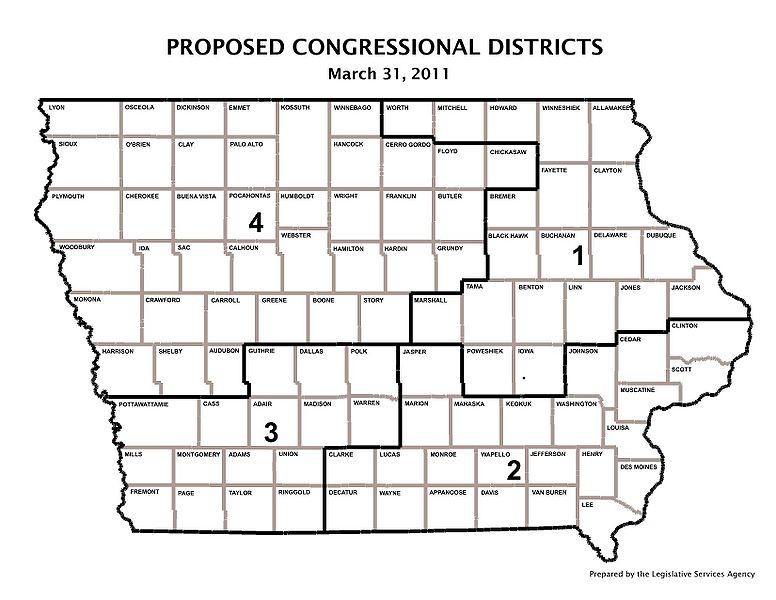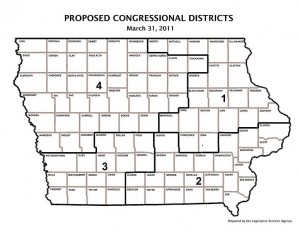
Last week Joe did a great job of breaking down the Republican Party’s 27-seat structural edge in State Assembly seats. The structural edge Republicans gave themselves in Assembly seats was made even more clear by the fact that despite the fact that Wisconsin’s Democratic Assembly candidates won 193,000 more votes across the state than their GOP counterparts this year, Republicans still hold a large majority in the State Assembly.
The results of the highly partisan (not to mention highly secretive) redistricting process by Republicans following the 2010 census underscore how flawed Wisconsin’s redistricting process is, and I’d love to see our great state move towards a redistricting process similar to the one in place in Iowa, in which the non-partisan Iowa Legislative Service Agency is responsible for drawing that state’s various legislative district lines, as opposed to the 49 other states that utilize a special commission or legislative committee to handle redistricting. Any redistricting plan presented by Iowa’s Legislative Service Agency must ultimately be approved by the Governor and the General Assembly.
The Iowa Legislative Services Agency uses computer software to generate a proposed redistricting map, disregarding all factors except population.[1] Although the legislature must still approve the final maps, this process has not been contentious in the past.[2] According to Ed Cook, senior legal analyst with the Legislative Services Agency, “The thing that makes us unique to most states is basically we don’t take into account any political information.”[3]
For congressional redistricting, the Iowa Code does not permit redistricting maps to split counties. For state-level redistricting, counties and cities should be split as little as possible. Greater leeway is given in splitting larger counties and cities. State law also mandates that all districts are drawn within one percent of their ideal population. Under the 2010 Census, ideal congressional districts for Iowa would contain 761,589 residents. Ideal State Senate districts would contain 60,927 residents, and ideal State House district would contain 30,464 residents.
So here’s how Iowa’s districts were drawn, based on population size.
For congressional districts, the ideal district is 761,589 residents. The proposed map showed only a .01% variance, a variance of less than 50 residents per district. For the Iowa House of Representatives, the ideal district would have 30,464 residents and the variance is 1.93%, a variance of less than 300 residents. For the Iowa State Senate, the ideal district would have 60,927 residents and the variance is 1.65%, a variance of less than 550 residents.
In contrast, while Wisconsin’s ideal State Senate district would have a population of just about 172,332 residents, its districts vary in population size from 197,821 on the high end to 152,758 on the low end, a variance of just over 11 percent in either direction of the ideal district size.
What’s more, while Wisconsin’s new Congressional districts are an illustration in how gerrymandering is accomplished, with those districts having little regard for county or municipal boundaries, Iowa’s Congressional districts were drawn in keeping with Iowa state laws mandating that counties cannot be split between Congressional districts. Here’s a look at Iowa’s Congressional districts.

And here’s a look at Wisconsin’s gerrymandered Congressional districts, which most definitely do not follow county or municipal boundaries.

To be clear, partisan gerrymandered redistricting can benefit either party – here in Wisconsin Republicans were the beneficiaries, while in Illinois Democrats were the beneficiaries – and while Iowa’s redistricting process may not be perfect, it certainly seems to me to be an improvement over the process in place here in Wisconsin.


Open Source software and publicly available data already exist that make the process painless (http://www.publicmapping.org/). Minnesota’s implementation is kind of fun to fart around with (http://www.drawminnesota.org).
Yes, Wisconsin could learn a lot from Iowa. I spoke those very words back in the 1983-84 legislative session.
I introduced the constitutional amendment to implement Iowa’s redistricting system in Wisconsin in at least three different legislative sessions during my tenure in the state legislature. Strange that Democrats, who were in a majority then, never allowed it to get passed the the hearing stage.
And isn’t it strange that when Democrats controlled both houses of the legislature in 2009-10, they rejected implementing an Iowa-like system then too.
And now they can’t wait to introduce it in the 2013-14 session. Guess the joke is on them. In this case, “Better late than never” does not apply.